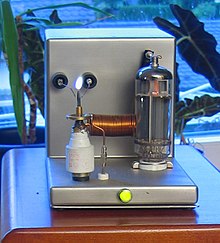
Plasma speakers or ionophones are a form of loudspeaker which varies air pressure via an electrical plasma instead of a solid diaphragm. The plasma arc heats the surrounding air causing it to expand. Varying the electrical signal that drives the plasma and connected to the output of an audio amplifier, the plasma size varies which in turn varies the expansion of the surrounding air creating sound waves.[1]
The plasma is typically in the form of a glow discharge and acts as a massless radiating element. The technique is a much later development of physics principles demonstrated by William Duddell's "singing arc" of 1900,[2] and Hermann Theodor Simon published the same phenomenon in 1898.[3]
The term ionophone was used by Dr. Siegfried Klein who developed a plasma tweeter that was licensed for commercial production by DuKane with the Ionovac and Fane Acoustics with the Ionofane in the late 1940s and 1950s.[4]
The effect takes advantage of several physical principles:[5] First, ionization of a gas creates a highly conductive plasma, which responds to alternating electric and magnetic fields. Second, this low-density plasma has a negligibly small mass. Thus, the air remains mechanically coupled with the essentially massless plasma, allowing it to radiate a nearly ideal reproduction of the sound source when the electric or magnetic field is modulated with the audio signal.
- ^ "Design and Evaluation of Electronic Circuit for Plasma Speaker, Severinsen, Daniel, Sen Gupta, Gourab 2013/07/01".
- ^ "Music in Electric Arcs". New York Times. Vol. 7. 28 April 1901.
- ^ Simon, Hermann Th. (January 1898). "Akustische Erscheinungen am electrischen Flammenbogen". Annalen der Physik. 300 (2): 233–239. Bibcode:1898AnP...300..233S. doi:10.1002/andp.18983000204. ISSN 0003-3804.
- ^ The Ionophone, L'Onde Electrique, S. Klein,1952
- ^ A New Speaker Principle, Saturday Review, Edgar Villchur,1952 Sep 27, page 60-61